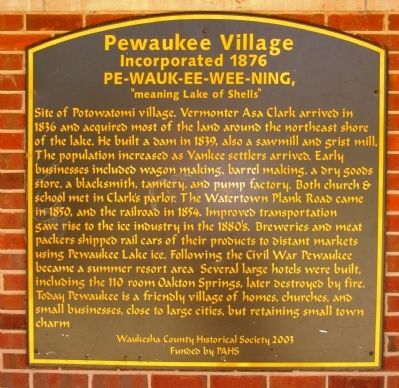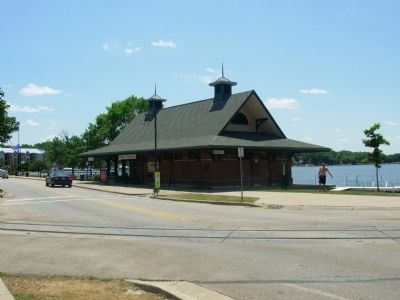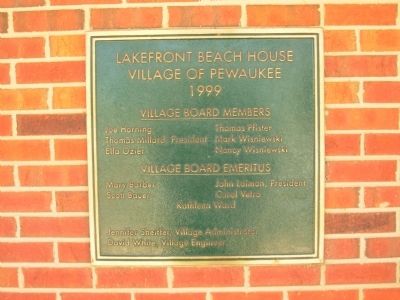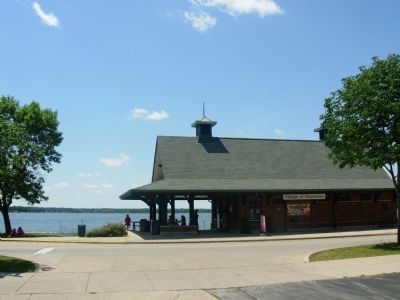Pewaukee in Waukesha County, Wisconsin — The American Midwest (Great Lakes)
Pewaukee Village
Incorporated 1876
— PE-WAUK-EE-WEE-NING, "meaning Lake of Shells" —
Erected 2003 by Waukesha County HIstorical Society, Funded by PAHS. (Marker Number 26-02.)
Topics. This historical marker is listed in this topic list: Settlements & Settlers. A significant historical year for this entry is 1836.
Location. 43° 5.107′ N, 88° 15.926′ W. Marker is in Pewaukee, Wisconsin, in Waukesha County. Marker is on Wisconsin Avenue, 0.2 miles south of High Street, on the right when traveling south. Marker is located on the Pewaukee Beach Changing House. Touch for map. Marker is in this post office area: Pewaukee WI 53072, United States of America. Touch for directions.
Other nearby markers. At least 8 other markers are within 4 miles of this marker, measured as the crow flies. Clark House Museum (approx. 0.4 miles away); Hon. Thomas Weaver Home (approx. 2.8 miles away); Waukesha Beach Amusement Park (approx. 2.8 miles away); Halquist Quarry (approx. 3.1 miles away); George Washington Burr Oak (approx. 3.7 miles away); Sussex Mills and Bug Line RR (approx. 3.9 miles away); First Woman in Town of Lisbon (approx. 4 miles away); St. Alban’s Episcopal Church (approx. 4 miles away). Touch for a list and map of all markers in Pewaukee.
Additional commentary.
1. Pewaukee Additional History
Pewaukee, called pee-wauk-kee-win-ick by the Pottawatomi and Menomonee, was home to many different tribes of Native Americans.
Many came to fish and hunt and moved on, but many also stayed and raised crops and made encampments here.
The first white man to visit the area was Samuel Starrow in 1817. He traded with the Native Americans for furs and hides.
In 1836 a Vermonter, Deacon Asa Clark, and a neighbor, Mr. Cheney, decided to look for opportunities on the western frontier. They came by horse to Milwaukee
where Asa purchased land on Snail Lake (Pewaukee Lake) to build a sawmill, gristmill, and dam. Deacon Clark then returned to Vermont to sell his farm.
On April 18, 1837, his son Timothy Clark and three other young men came to the site in Wisconsin his father had chosen. They came by stagecoach, runners, train, canal boat, steamer, and schooner, to reach Milwaukee and then by horseback to reach the land site. Asa had paid $80 for a jack-knife claim. In late August, Deacon Clark and his family came.
The first school was held in 1840 in Asa Clark's home. The Watertown Plank Road was built in 1850 allowing products and passengers to travel more comfortably between Milwaukee and Watertown with a stop in Pewaukee. Tolls were charged at 10-mile intervals except for those going to church, a funeral, or required court appearance or military duty.
Churches began forming in the 1840s with the Congregational Church being the first. Later came the Baptist Church, the Methodist Church, the Catholic Church, the Lutheran Church, and the Episcopal church.
After the Civil War, the Summer Resort Era began in Pewaukee. Two famous resorts in Pewaukee were Oakton Springs and Heath's among many more. The owner of Oakton, Col. Iglehart, chartered a special train from Oconomowoc to transport the Lady of the Lake, a side-wheel steamer which held 150 passengers, to Pewaukee Lake for the many resort tourists. Summer homes or cottages sprang up quickly on the lake for city dwellers that wanted to spend some time away for relaxation.
The ice industry was a huge part of Pewaukee history. There was a natural millpond where the ice could be cut. In 1854, the ice could be shipped by train. By 1876 ice was shipped to breweries in Milwaukee and meat packing houses in Chicago.
Today, Pewaukee is a friendly village of homes, churches, and small businesses, close to large cities, but retaining small town charm.
— Submitted April 12, 2013, by Linda Hansen of Waukesha, Wisconsin.
Credits. This page was last revised on October 16, 2020. It was originally submitted on July 12, 2011, by Paul Fehrenbach of Germantown, Wisconsin. This page has been viewed 1,492 times since then and 79 times this year. Photos: 1, 2, 3, 4. submitted on July 12, 2011, by Paul Fehrenbach of Germantown, Wisconsin. • Bernard Fisher was the editor who published this page.



